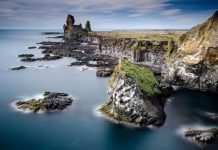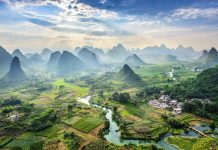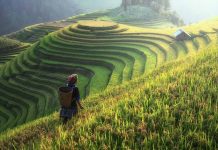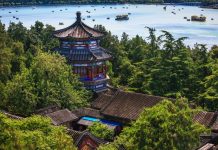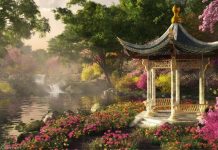One of the best examples of Buddhist cave art in China, the YUNGANG caves, created in the 5th century, are inexpressibly beautiful. In comparison with them and their 51 thousand statues, all other attractions of the province pale.
The Yungang caves with all their statues were cut down by the people of the Turkic-speaking Toba tribe under the influence of the art of the Indians, Persians and even Greeks, with whom the former nomads got acquainted thanks to the Silk Road. The work began in 460 and lasted for 60 years. As a result, China’s oldest collection of Buddhist sculpture has emerged, resting in 252 grottoes.
39 caves containing masterpieces of religious art are open to the public. Despite the time and bad weather, many statues retained their coloring, which cannot be said about the later sculptures of Longmen. Some caves still attract believers. In the old days, wooden temples were attached to many caves — they were preserved in grottoes No. 5. 6, and 8.
In the interior of some caves, altars in the form of small square pagodas have been preserved, while others are painted on the walls as if they were covered with wood. Although the frescoes have not been restored for centuries, you can still see elegant animals, birds and celestial beings on them. In the decor of almost all caves there is a motif of 1000 Buddhas – many small statues of the Enlightened One are seated in niches that cut the walls.
Eight grottoes serve as a haven for giant Buddhas, the largest of which is in grotto N” 5. A giant 1m tall depicts Shakyamuni Buddha, his face has retained a layer of gilding. The frescoes of this cave are badly damaged, but you should still take a closer look at the paintings on the ceiling. In the grotto No. 6, shining with eternal colors, all the splendor of the paintings that evoke associations with the mysterious temple from the Indiana Jones movie epic has been preserved. In the center of the cave stands a wooden pagoda touching the ceiling. On each of its four sides, an image of the Buddha is carved. All visitors pay attention to the inscription in red oil paint right on top of the priceless frescoes. The hieroglyphs mean “Secondary School No. 8, Datong”. Another graffiti was left by someone from Pingyao – obviously, both inscriptions appeared during the Cultural Revolution.
Damage caused by people or bad weather is visible everywhere. Grotto No. and grotto No. 8 were badly damaged. Air pollution also has a bad effect on the state of Yungang.
Numbers 16 and 20 indicate the oldest caves of Yungang, created under the supervision of Monk Tanyao. Go to grotto No. 18 to appreciate how artfully the expressive faces of people are carved out of stone. Cave No. 19 preserves the peace of the 16.8-meter statue of Shakyamuni. Another popular image is Maitreya, or the Buddha of the Future, sitting in grottoes No. 1 and 13. In the second of these caves, the statue is covered with autographs of hard workers from Hoho go.
Grotto No. 20 resembles the Cave of the ancestors in Longmen. Once there were three statues of Buddhas — Past, Present and Future. The central one has survived and is considered a symbol of Yungang, while the left one has been lost. In many grottoes, statues are decapitated — for example, in grotto No. 39. The figures exposed to natural forces, for example, located at the entrances to caves, suffered the most.
In Yungang, you can be provided with an English-speaking guide, although all caves have explanatory inscriptions in this language. For Y10, you can take a picture on the back of a mangy camel.
The Great Wall of China
The Great Wall in these places is not as majestic as in the vicinity of Beijing. The strongest bricks of the Ming era are too valued by local peasants to stay in their rightful place. As a result, the lining of the Shanxi sites has long disappeared, and nothing protects the inner earthwork from the destructive effects of water and wind.
It will take you half a day to visit a section of the Wall several hundred meters long to the north of Deshenbao, a fortress of the XVI century, which has now turned into an ordinary village. Take any bus going towards Jining, pay for a ticket to Fengzhen and ask the driver to drop you off at Deshengbao. Buses depart from Datong’s main bus station, but it is more convenient to intercept the car at the railway station, where it stops on the way. The last bus in the opposite direction departs at 18.30.
A more remote, but interesting option for hiking is to go to the Changcheng site near the village of Bataicun. There, the Wall meanders along the crests of the mountains, going east to Beijing and west, where it soon turns sharply to the Yellow River flowing south. At the main bus station in Datong, take the bus to Jun. There, change to the one that goes to Santun. If you ask, the driver can take you directly to Bataitsun — it will take half an hour and Y20-30. Don’t forget to arrange to be picked up on the way back!
HANGING MONASTERY
Built on the sheer wall of a giant cliff, the Buddhist Hanging Monastery is supported by long and thin supports. The temples and halls of the monastery repeat all the irregularities of the rock wall and are connected by corridors hanging over the abyss.
If there are not many passengers on the bus from Datong, you will be dropped off in the town of Hunyuan and taken to the monastery by a free taxi. Theoretically, the same thing awaits you on your return to Datong. If you want to get from the monastery to the Wooden Pagoda, you will have to take a taxi to Hunchun and there take a regular bus to Muta.
MUTA
The slender five-tiered tower was built in 1056 and is considered the oldest and tallest wooden pagoda in the world. The terracotta reliefs and sculptures decorating the interior of the Mut can boast of an equally venerable age. Unfortunately, visitors are allowed no higher than the 2nd tier. Photos of the upper floors of the pagoda are posted on a special stand.
The muff is located in Yingxian County. On the date, some buses depart from the new South Bus station and stop right behind the pagoda. To continue towards the Wutaishan Mountains or return back to the provincial capital, take a taxi to the eastern bus station. Rather, it is a crossroads of highways, where bus traffic stops at 15.00. To get to Tai, take a taxi to the western bus station. Buses to Taiyuan regularly depart from there from morning until 13.30.



